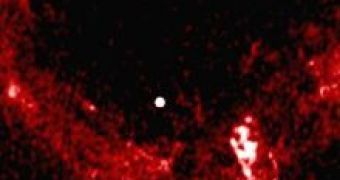Astronomers have gotten their deepest glimpse into the heart of our Milky Way Galaxy, peering closer to the supermassive black hole at the Galaxy's core then ever before.
Using the National Science Foundation's continent-wide Very Long Baseline Array (VLBA), they found that a radio-wave-emitting object at the Galaxy's center would nearly fit between the Earth and the Sun. This is half the size measured in any previous observation.
"We're getting tantalizingly close to being able to see an unmistakable signature that would provide the first concrete proof of a supermassive black hole at a galaxy's center," said Zhi-Qiang Shen, of the Shanghai Astronomical Observatory.
A black hole is a concentration of mass so dense that not even light can escape its powerful gravitational pull.
A mass equal to four million Suns is known to lie within Sagittarius A*, and the new measurement makes the case for a black hole even more compelling than it was previously. Scientists simply don't know of any long-lasting object other than a black hole that could contain this much mass in such a small area. However, they would like to see even stronger proof of a black hole.
Many galaxies are believed to have supermassive black holes at their centers, and many of these are much more massive than the Milky Way's black hole. Also, in many other galaxies, the gravitational energy of the black hole is powering superfast "jets" of subatomic particles at nearly the speed of light. Such jets in other galaxies extend outward for thousands of light-years.
The Milky Way's central black hole is much less active than that of many other galaxies, presumably because it has less nearby material to "eat." Astronomers believe that the radio waves they see coming from Sagittarius A* probably are generated by particle jets much shorter than those of more-active galaxies.

 14 DAY TRIAL //
14 DAY TRIAL //